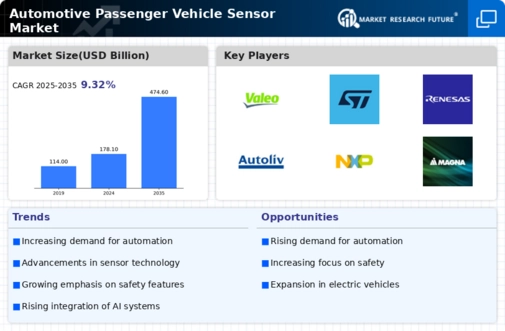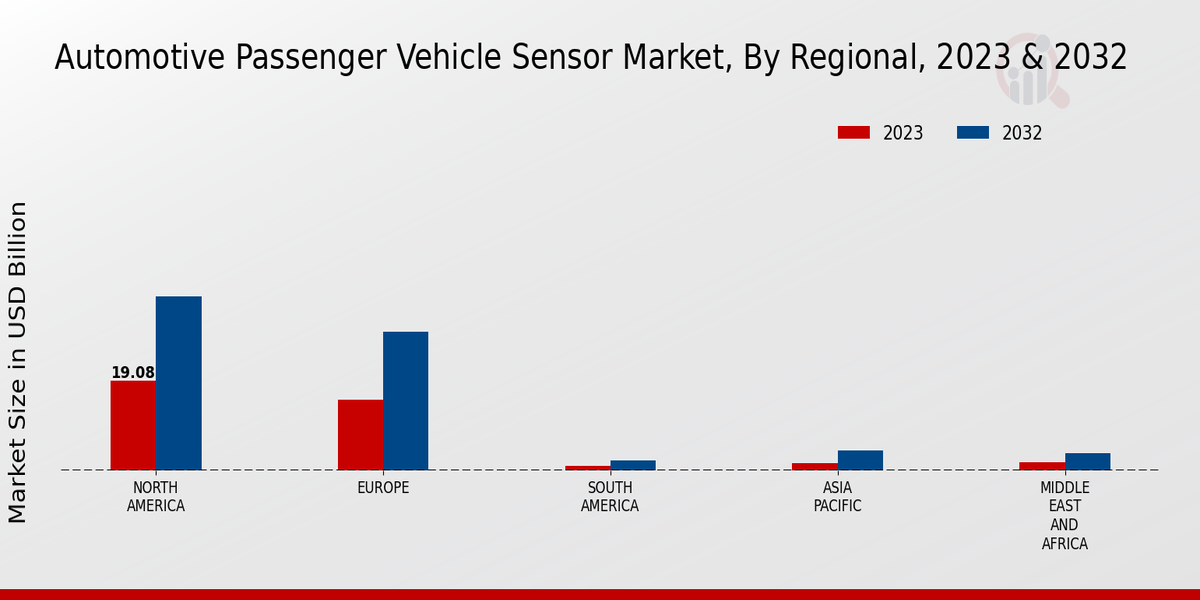Regulatory Compliance
Stringent government regulations regarding vehicle safety and emissions are influencing the Global Automotive Passenger Vehicle Sensor Market Industry. Governments worldwide are mandating the inclusion of advanced safety features in new vehicles, which necessitates the use of various sensors. For example, the European Union has implemented regulations requiring all new cars to be equipped with ADAS by 2022. This regulatory push is likely to increase the adoption of sensors, thereby expanding the market. As compliance becomes a critical factor for manufacturers, the industry is expected to see a robust growth trajectory, potentially reaching 474.6 USD Billion by 2035.
Market Growth Projections
The Global Automotive Passenger Vehicle Sensor Market Industry is projected to experience substantial growth over the next decade. With a market valuation of 178.1 USD Billion in 2024, it is anticipated to reach 474.6 USD Billion by 2035, reflecting a compound annual growth rate of 9.32% from 2025 to 2035. This growth is driven by various factors, including technological advancements, regulatory compliance, and increasing consumer demand for safety features. The market is poised for expansion as manufacturers continue to innovate and integrate advanced sensor technologies into their vehicles.
Rise of Electric Vehicles
The rise of electric vehicles (EVs) is reshaping the Global Automotive Passenger Vehicle Sensor Market Industry. As EVs become more prevalent, the demand for sensors that monitor battery performance, thermal management, and energy efficiency is increasing. These sensors play a crucial role in optimizing the performance and safety of electric vehicles. Furthermore, many EV manufacturers are incorporating advanced sensor technologies to enhance user experience and vehicle automation. This trend indicates a shift in the automotive landscape, with the market poised for substantial growth as the adoption of EVs accelerates.
Technological Advancements
The Global Automotive Passenger Vehicle Sensor Market Industry is experiencing rapid technological advancements, particularly in sensor technologies such as LiDAR, radar, and cameras. These innovations enhance vehicle safety and automation, driving demand for advanced driver-assistance systems (ADAS). For instance, the integration of high-resolution cameras and sophisticated algorithms allows for improved object detection and collision avoidance. As vehicles become increasingly equipped with these sensors, the market is projected to grow significantly, with a valuation of 178.1 USD Billion in 2024. This trend suggests that ongoing research and development will continue to propel the industry forward.
Consumer Demand for Safety Features
There is a growing consumer demand for enhanced safety features in vehicles, which is significantly impacting the Global Automotive Passenger Vehicle Sensor Market Industry. Consumers are increasingly aware of the benefits of advanced safety technologies, such as automatic emergency braking and lane-keeping assistance, which rely heavily on sensors. This heightened awareness is driving manufacturers to incorporate more sophisticated sensor systems into their vehicles. As a result, the market is expected to witness a compound annual growth rate of 9.32% from 2025 to 2035, reflecting the increasing prioritization of safety in automotive design.
Integration of IoT and Connectivity
The integration of Internet of Things (IoT) technologies and connectivity features is transforming the Global Automotive Passenger Vehicle Sensor Market Industry. Connected vehicles utilize a network of sensors to communicate with each other and infrastructure, enhancing safety and efficiency. For instance, vehicle-to-everything (V2X) communication relies on sensors to share critical information about road conditions and traffic. This connectivity not only improves driving experiences but also supports the development of smart cities. As the demand for connected vehicles rises, the market is likely to expand, driven by the need for advanced sensor systems that facilitate seamless communication.






















